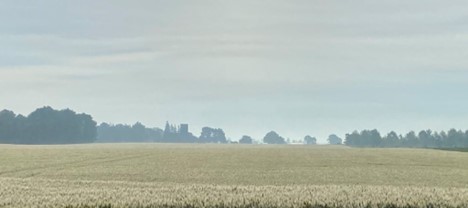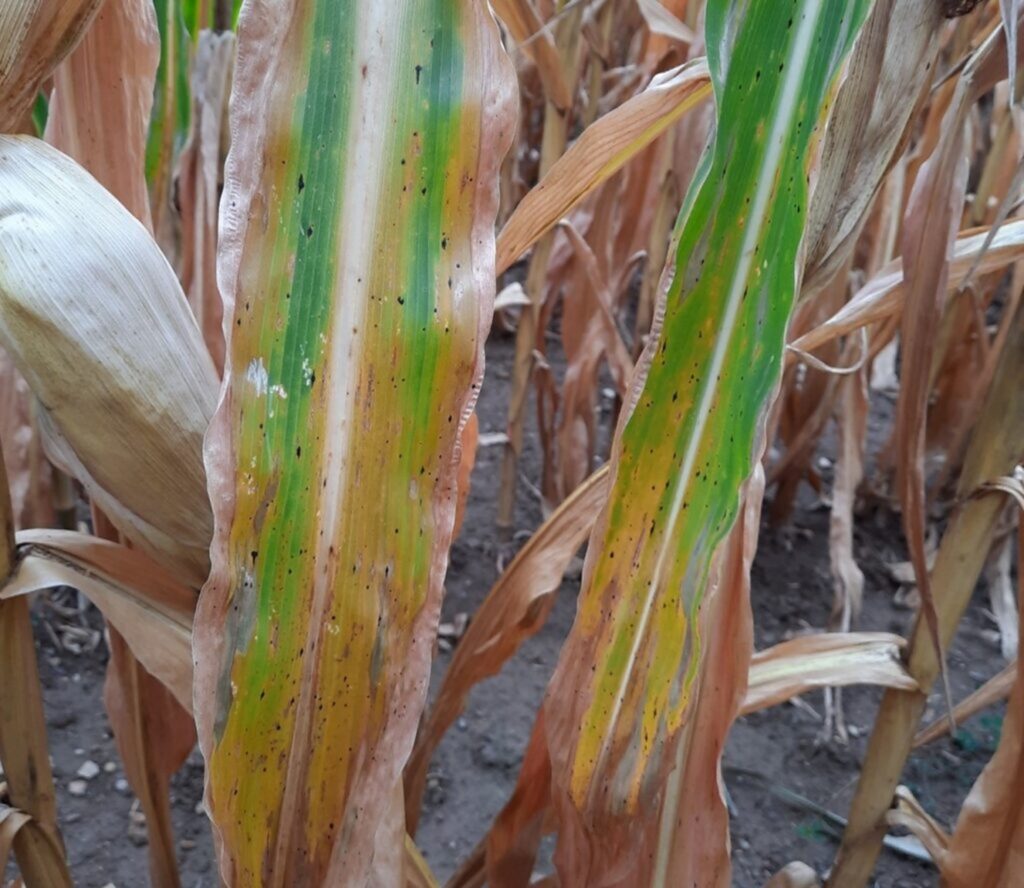Planting
In April 2023, Statistics Canada estimated Ontario farmers intended to plant 2.3 million acres of grain corn, 5% higher than the 5-year (2018-2022) average seeded acres of 2.19 million acres (OMAFRA Crop Statistics).
A warm sunny window opened for one week starting the Easter weekend (April 7 to 9) and provided a small opportunity for tillage on very light or well drained soils, as well as a very small amount of corn acres to be planted. Cool and damp conditions prevailed for the next several weeks. Corn planting did not start in earnest until the second week of May (week of May 7) when sunny and warm weather returned. Planting started on lighter soils early to mid-week and was well underway for most areas by the end of the week. By the middle to end of the following week (week of May 14), corn planting appeared to be nearly complete in many areas.
Some emergence issues were reported for very early April planted corn, though stands were mostly suitable for keeping. Emergence was relatively quick for May planted corn with early May planted corn emerging the beginning of the 4th week of May (week of May 21) and most corn fields emerged by the end of that week. Very hot and sunny weather during the last week of May resulted in exceptionally quick corn growth, as much as 2 or 3 leaf stages in some fields in one week.
Final grain corn planting estimates for the province were 2.26 million acres (OMAFRA Crop Statistics), similar to the April planting intentions and slightly higher than the 5-year average.
Early Season
With warm dry conditions prevailing, late May and June was favourable for in-crop Nitrogen (N) management. Side-dressing N generally started by the first week of June. Many fields were closing rows by the week of June 25. Conditions remained dry through the end of June, but the odd rain event prevented any real moisture-stress symptoms. The crop looked excellent and uniform in most areas. By late June, crop heat units (CHU) were approximately 50-100 CHU, which were ~5-10% below the 10-year average for many parts of Southern/Eastern Ontario, but similar to or slightly above normal for Northern Ontario.
One unusual experience through June was smoke from wildfires (Figure 1). The degree of smoke varied depending on the day and the area of the province (worse in Eastern and Northern Ontario). Wildfire smoke can have both negative and positive effects, although research on crop growth impacts is limited. Given that most smoke occurred during early vegetative stages, impacts on Ontario’s corn crop were likely minimal (https://bit.ly/3tjK8A0).

Figure 1. Haze from wildfire smoke in 2023.
Pollination and Grain Fill
Dry weather broke the first week of July when heavy rains were received across many areas. General weather instability continued through much of July with frequent rain and thunderstorm events through Southern/Central/Eastern Ontario.
Rains can bring concerns of nitrogen (N) losses. Given the dry start to the growing season and significant rainfall not arriving until later vegetative stages, rainfall related N-losses were likely not widespread in 2023 (https://bit.ly/3Tou9eG). Precipitation from mid-June through mid-July has been shown to be closely related to corn yield potential in Ontario, which can consequently drive N requirements. With higher yields, it is possible that 2023 was a more responsive year for N. Although not many reported obvious N deficiencies – 2023 would have been an excellent test year for on-farm N trials.
While tassels began emerging in the earliest fields the third week of July (week of July 16), tasseling and pollination began in earnest the last week of July (week of July 23) and continued through the first week of August. Moisture and temperature stress were of little concern and fields generally looked excellent at this time. Western bean cutworm peak moth flights generally occurred during the latter half of tasseling/pollination in many areas.
Regular rainfall continued through most of August, including very heavy localized events. Given the wet corn canopies through most of the summer, concerns were surfacing over the potential for ear moulds and foliar leaf diseases, particularly tar spot. Cooler than normal temperatures through July and August left many hoping for heat or a long open fall to finish grain fill. By mid-September, many areas of southern, central and eastern Ontario were 200-300+ CHU (~10%) behind the 10-year average. Grain fill was behind where it normally would be for the time of year.
Harvest
Corn silage harvest was delayed with later crop maturity. Silage harvest appeared to peak the last week of September through the first week of October. This coincided with unseasonably hot weather (daytime highs of 25-30°C). While the hot temperatures maybe presented a challenge for silage moistures, it was well received for grain corn maturity. An estimated 253,000 acres of corn silage was harvested, slightly lower than the 5-year average of 260,000. Average yields were equal to the 10-year (2013-2022) average of 20 ton/ac as fed (OMAFRA Crop Statistics).
The annual ear mould and DON (vomitoxin) survey was completed October 2nd to October 5th. The purpose of the survey was to measure the relative levels of DON in the grain corn crop just prior to harvest to provide information for growers and industry. A total of 192 samples were collected across the province. Visual mould and DON levels were higher than normal with 23% of samples testing at or above 2 ppm (10-year average is 12% of samples). While this was higher than normal, this was still much lower than 2018 where 40% of samples tested above 2 ppm. Higher testing samples were generally more noticeable in Southwestern Ontario. Final report is available at Fieldcropnews.com (https://bit.ly/483OVEM).
While still representing only a minority of samples overall, insect feeding appeared slightly greater than normal in 2023 survey samples. Peak western bean cutworm moth flights generally coincided with the latter half of tasseling in many areas, which may have been a factor. Mould symptoms were more apparent where feeding damage was present.
With late maturity and high grain moistures, corn harvest was very slow to start. Harvest in October was limited but started in earnest for many areas as the calendar switched to November (week of October 29). Progress was variable with weather conditions. The third week of November (November 12) saw very warm and sunny conditions which moved harvest quickly. By the end of this week, some areas were nearly complete while others were just getting started. Harvest across the province was likely over half done. While the majority of crop appeared harvested by December 1, it was not uncommon to find pockets of the province with some corn still standing.
In general, many reported average to above average (or record) yields. Some reported yields were trimmed in areas of heavier or poorly drained soils where excessive rainfall events were received, though these were relatively localized.
Like in most years with elevated rainfall levels, DON reports were highly variable, and higher testing corn was more common to southwestern Ontario. Wet corn canopies during silking and most of the grain fill stage were favourable for ear mould establishment and growth. Testing was common at harvest and several commented that there was a good supply of low testing corn and DON issues appeared to be related to higher risk hybrids or local areas. While DON presented local challenges, overall levels and quantities were reported to be much more manageable than in 2018.
Estimated grain corn yield for Ontario is 171 bu/ac (OMAFRA Crop Statistics), 4% higher than the 10-year average of 165 bu/ac (2013-2022). The 2023 Ontario hybrid corn performance trial results are available at the homepage of gocorn.net or https://bit.ly/46TO20p. Several options exist for viewing the performance data, including printable PDF, sortable spreadsheets (yield index, moisture, lodging, company or hybrid name etc.) and yield by moisture graphs, demonstrating the trade-off between yield and harvest moisture of hybrids within each Ontario Corn Committee (OCC) table.
Things to Watch in 2024 and Beyond
DON Testing Variability
Ontario research from 2018 shows that one of the greatest sources of variability in DON testing comes from collecting the subsample for DON analysis (e.g., the 200g analysis sample that is collected and finely ground from the 2kg bulk probe sample). Because individual corn kernels can be highly variable in DON and coarse in size relative to the analysis subsample (e.g., a 200g whole kernel sample used for fine-grinding may be representing the entire load with only 500 kernels), the whole 2kg bulk sample should be ground (at least coarsely) and mixed so the analysis subsample contains parts of all kernels in the bulk sample. This subsample can then be ground finer to meet specifications of the DON test. Because most grinders cannot quickly grind large amounts of wet corn, a high-capacity wet grinder has been developed in Ontario to help solve this issue (https://bit.ly/488EzE1). There is cost-share funding opportunities for DON grinders and other relevant plant health practices through the OMAFRA Biosecurity Enhancement Initiative funding. Applications are being accepted on an ongoing basis until January 6, 2025, subject to the availability of funding allocated to the Initiative. For more information, call OMAFRA’s Agriculture Information Contact Centre (AICC) at 1-877-424-1300.
Tarspot
First observed in Ontario in 2020, tarspot has successfully overwintered and is now established in the province. Spread by wind-blown spores, black fruiting structures called Stromata (Figure 2) can be found in corn in all counties west of Toronto, especially during wetter years like 2023. Cool and humid canopies with prolonged leaf wetness, much like 2023, are very favourable for tarspot development. While stromata could be observed at low levels in many fields in 2023, disease pressure at yield-reducing levels was generally limited to far southwestern Ontario (i.e., south and west of London).
Growers should remain vigilant. Whether tar spot becomes an issue in 2024 depends on weather conditions. Cool and humid canopies with prolonged leaf wetness like 2023 are favourable for development. Infections are most severe in corn-on-corn fields where tar spot was present in the past. Corn residue serves as a source of inoculum for earlier infection in those fields. Ontario research is looking at hybrid tolerances and fungicide management options. For more information, see resources at CropProtectionNetwork.org.

Figure 2. Black tar spot fungal structures (stromata) on corn leaves in September.